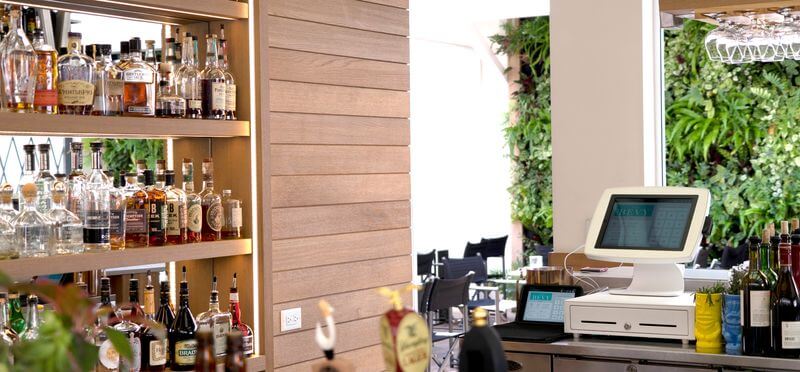
McDonalds, KFC, Subway, and Starbucks have all started adding more eco-friendly practices to their restaurants. What’s your restaurants’ Eco-Friendly Score? Having a sustainable restaurant is not only good for the environment but can also help bring in more business and save money. Check out our five tips on how to make your restaurant eco-friendlier.
Modern ideas for resource management have paved the way for paperless receipts, paper straws and reusable cups (which by the way are great for marketing). They have changed the way businesses affect the environment. This new focus is a product of a more eco-conscious consumer. The millennial generation has brought upward trends in healthy eating and more sustainable living conditions. Businesses, such as restaurants, must adhere to in order to stay relevant and appealing.
Use Non-Toxic cleaning products instead of chemicals.
Among the top factors a restaurant considers when it comes to cleanliness is the clean-up protocol. Frankly, there are more restaurant cleaning products that are toxic than natural non-toxic options, and costs can run high oneco-friendly cleaning products. However, with the right kind of inventory tracking system you can cut waste and maximize time to make-up for the added costs. Browsing online you will see a plethora of new, and more affordable, options to get your restaurant eco-approved.
Tip: When you are shopping around, look for the Green Seal label, Environmental Choice Program label, Greenguard label, or the Chlorine Free Products Association label.
Buy Sustainable Equipment
Using efficient equipment in your restaurant is a decision that will pay for itself. While it’s very easy for a restaurant to rack up costs when it comes to electricity. Even though costs can start high, having energy efficient equipment will create a sustainable restaurant and consequently it makes less of an impact on the environment. Look for things like high-efficiency toilets, energy star appliances, and eco-friendly refrigeration equipment. Small details can make a difference as well, such as making sure all your equipment like POS system terminals, lights, and ovens are turned off at the end of the day.
Did you know? The ENERGY STAR program for commercial buildings helped businesses and organizations save nearly $10 billion in energy costs in 2016, contributing to a savings of over $150 billion since 1992.
Go paperless as much as possible.
Brace yourself, the digital age is upon us! The focus many businesses have begun to really adopt is reducing paper, as it is easier than ever. Receipts can lead to pretty significant costs and are no longer necessary. Customers will almost always prefer a digital receipt that can be emailed or sent via text message to their phone. Aside of the clear benefits to the environment and all our wonderful trees, it is a more secure way of keeping records. Does your POS system allow you to send digital receipts? If not, you should consider one that does. Another way to reduce printing is to install kitchen order display screens. These screens show kitchen staff pending orders in real-time, instead of using paper print outs that can be misplaced, or incorrectly filed.
Tip: Try cutting your paper advertising campaigns and move your time and marketing dollars online. There are more affordable options you can use like AdWords, Facebook, Instagram, YouTube and others.
When you save water, you save money.
Just like paper, water is a resource that can be costly for businesses that do not monitor it carefully. Water costs can easily add up in a restaurant. Did you know that letting a faucet run for five minutes can waste around 10 gallons of water and uses enough energy to power a 60-watt light bulb for 18 hours? These small habits in the kitchen, or an unattended washroom sink that is left running can all contribute to a yearly expense that is not necessary. Checking that piping and plumbing is in good conditions is another commonly avoided maintenance duty for restaurants. However, it is critical to check all the restaurant’s pipes for leaks. A leaky faucet can lead up to thousands of gallons lost per year.
Tip: Other ways to conserve water is to only serve water to guests who ask for it, only run the dish washer when it is full, and only thawing food in the refrigerator instead of under a faucet.
Support a cause, community service campaign, or start your own!
Giving back and caring about the environment is the hottest trend, and that’s great news! People love hearing about good causes that their favorite business is involved with, and it helps build customer loyalty. By promoting good causes and eco-friendly ways of running your business you will be leading by example and building good publicity. Don’t forget to spread the word of your eco-friendly practices through social media and other marketing platforms as well as you may gain a fan just by appealing to a viewer’s beliefs. According to an Ohio State University study 8 to 10 consumers are willing to pay more for a “green” dining experience. Start spreading the word of your eco-friendly business today.
Tip: Once your restaurant has implemented a green strategy, make sure to list your restaurant in green business directories that can be found online. While this by itself is not a green activity, it helps you attract green-conscious customers and proves your legitimacy by having your name listed in legitimate, useful directories.

